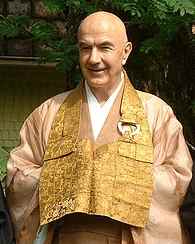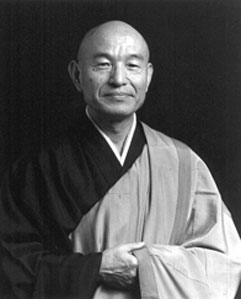SelfDefinition.Org
The Zen Master in America
Dressing the Donkey with Bells and Scarves
by Stuart Lachs

2. Richard Baker Roshi
Text
"Only when you give up everything can you see a true teacher. Even the name of Buddhism is already a dirty spot on our practice. The character and effort of our teachers is our teaching." [30]
In December, 1971, shortly before his death, Shunryu Suzuki roshi gave Richard Baker Dharma transmission in the Sōtō sect of Zen, thus making Baker, for his students and for all future people in his lineage, an authentic link to the historical Buddha. [31]
As such, Baker became the official teacher and Abbot [32] of the San Francisco Zen Center (SFZC) and Shunryu Suzuki's sole western heir. This Dharma transmission set in motion the financial, behavioral, and sexual scandal at the SFZC that culminated in 1983. Unfortunately, this scandal was not unique in American Zen history, for there are few major centers untouched by such scandals. [33] The Baker/

Richard Baker, 1980
These scandals and their accompanying toxic consequences all too often arise because the Zen master is not only presented as someone he is not, but all too often, he comes to believe he is someone he is not. Zen mythology presents the master as a perfected being with a system of symbols and rituals that enhances his legitimacy. This imputed legitimacy obscures the power relation which, though having an aspect of technical competence, is actually a matter of institutional authority. There is a process of misrecognition: "the process whereby power relations are perceived not for what they objectively are, but in a form which renders them legitimate in the eyes of the beholder." [34] Bourdieu's remark, "the prophet always preaches to the converted," has particular relevance throughout this paper.
The scandal at the SFZC involved Baker's high living, [35] generally arrogant behavior, controlling ways, [36] lying to and bullying his students, [37] as well as a number of extra-marital affairs with women, both students and non-students.
Baker was able to get away with such bad behavior, in part, because of the way he manifested his authority. He gave his followers two choices: obey his words without question or be marginalized. Being marginalized was tantamount to being forced to leave, a choice that was too painful for many people to contemplate. Leaving meant giving up what made life seem most meaningful, leaving close friendships and the joy of community. Therefore, in their need to remain at the Center, members recognized, consciously or unconsciously, a powerful incentive to buy fully into Zen's mythology. This was especially true of some of the older students and of people wanting to climb Zen Center's ladder to positions of authority, power, and prestige, which was totally dependent upon Baker's sanction. As Upton Sinclair said, "It is difficult to get a man to understand something when his salary depends on not understanding it." Obedience, subservience, and discipline were well rewarded at a large institution like the San Francisco Zen Center. Baker controlled rewards, such as providing a chance to live well at Green Gulch farm and granting positions of authority and respect at Tassajara monastery or the City Center. On the other hand, he dealt severely with people who stood up to him or spoke against him. According to Downing, almost everyone recalls "a pervasive and sometimes punitive atmosphere of silence and secrecy." [38]
A look at the relationship between Baker and Suzuki provides some illumination into how Baker became so powerful. Let us review for a moment, Baker's introduction to Suzuki's edited words in the well-known book, Zen Mind, Beginner's Mind,and its description of Suzuki as the ideal of a fully realized Zen master.
What the teacher really offers the student is literally living proof that all this talk [of the idealized Zen master] and the seemingly impossible goals [of Zen] can be realized in this lifetime. [39]
Presenting the master as a fully enlightened being is an integral part of creating the Zen habitus, wherein the master is understood to be beyond the understanding of ordinary people and is to be treated as such. Here, too, is an example of enhancing one's own prestige by boasting of the attainment of one's teacher, since Baker knew as early as 1967 that Suzuki wanted him to be his successor. [40]

Richard Baker
Consequently, from this vantage point, we witness Baker acting with flagrant hypocrisy. He has many extra-marital affairs, yet he scolds his students for flirting. A senior student relates how in 1982 at a Zen Center priest's meeting, that he, Baker launches into a "diatribe about [Eido Shimano roshi] the teacher at the Zen Studies Society in New York, who has for years been involved sexually with his students. Dick ranted how terrible this guy was…" [41] Given Baker's track record with his own students, this is, at best, hypocritical, at worst, it could be taken as evidence of the very delusions a Zen master was supposed to avoid falling prey to. One affair, the one with his best friend's wife, [Anna Hawken, wife of the cuckolded Paul Hawken] was conducted quite openly at the Center's monastery Tassaraja, during a Peace Conference attended by Zen master Thich Nhat Hahn, Robert Aitken roshi, the poet Gary Snyder and other notables. In fact, it was this affair that led to the meltdown of 1983.
Baker demonstrated little restraint and acknowledged little responsibility for his actions. A senior student relates how Baker "told people that Anna had seduced him, and what was he supposed to do?" Yet, another senior student relates what Anna told the Board of Directors: "She told the Board he came by day after day and gave her cashmere sweaters, and paintings, and statues, and wore her down. She said she'd been more or less happily married." [42]
Japanese Zen emphasizes jiriki, [43] or self-power, which is, in part, about taking responsibility for one's actions. Where was the jiriki in Baker, Zen roshi of the leading Zen center on the West Coast?
There was an apparent moment of jiriki in September of 1983, when Baker sent a letter to the Center, apologizing to his best friend and the other people he may have hurt. He was writing from France while staying at the Center of the world famous Vietnamese Zen master and peace activist, Thich Nhat Hahn. A few weeks later Nhat Hahn wrote a letter to the SFZC exhorting the community to assist and support Richard while "endorsing the sincerity of Richard, whom he considered absolutely trustworthy." [44] Interestingly, Nhat Hahn attended the peace conference at Tassajara where Baker and Anna, according to Gary Snyder, walked around hand in hand, openly displaying their affair. [45] Her husband arrived and, when he realized what was happening, became visibly disturbed. Senior members feared he would harm himself. A week later Baker and Anna together attended a talk of Nhat Hahn's.
Nhat Hahn never wrote to the Board of Directors of the SFZC to ask them about Richard and Anna, to ask what they thought happened, what was their view of the story, if there were other problems, how long things had been troubling people, and so on. Yet, he had just written vouching for Baker's sincerity and trustworthiness. Did Baker and Nhat Hahn recognize in each other, in their role as Zen masters, a special class of the enlightened, sacred beings that did not require asking the other, the "usual people," for their opinions or views? [46] Did they, thinking of themselves as "enlightened masters" fall prey to their own myths?
Once again, however, Baker's commitment to jiriki failed. In 1989, six years after being forced to leave, Baker threatened to take back control of the Center through litigation. This threat cost the Center $35,000-$40,000 in legal fees. Baker finally dropped the case, saying he was pressured to push the suit by a lawyer who was a student of his. Baker said, "There was a lawyer who kept bugging me." [47] It seems that Baker roshi could not accept the most basic Zen idea of being responsible for what you are doing. It follows that if you blame other people you never try to work on yourself. [48] A more fundamental concept could scarcely be imagined in any social system, secular or religious.
One wonders if Baker succeeded so long, not because he was a cynical calculator who consciously deceived people, but, rather, because he was someone who, in all good faith, took himself to be something that he was not, the "legitimate imposture." [49] There are several factors that might have led Baker to believe that he was more than he was: 1) the axiom-like Zen rhetoric of unbroken lineage that connected him to the historical Buddha, 2) the myth about Dharma transmission and the supposed enlightenment of the Zen master, 3) the idolized Suzuki roshi's emphasizing that Baker's transmission was "real," [50] 4) the hundreds of students and visitors bowing to his authority along with the special position granted him during the many rituals that take place in Zen, 5) the large public and solemn ceremony communicating to Baker and all others, his new identity as an enlightened Zen master. One of the mechanisms that allowed all of this to work, in all innocence and with utmost sincerity, was that his interests and the interests of those he represented, his disciples, often coincided. In this way, he could believe and get his disciples to believe that he had no interests outside of theirs. [51]
Baker's purchase of a new white BMW became a symbol for much of the anger, resentment and pain that Zen Center members came to feel towards him. Baker was impressed that his peers, est founder Werner Erhard and the well known Tibetan teacher Trungpa, had chauffeurs and large Mercedes, so "I thought I should buy a car." [52] During his interview with Downing, Baker roshi, a husband and father, explains that having girlfriends, eating fancy dinners, and driving a "nice car" were implementing Suzuki roshi's commitment to lay practice. And then, there are the words of Virginia, Baker's wife of twenty-one years, to a friend, which add another dimension: "You know, Yvonne, Dick is crazy." [53]
Notes, part 2
[30] Chadwick, David, The Crooked Cucumber: The Life and Zen Teaching of Shunryu Suzuki, Broadway Books, 1999, p. 146. Words in italics following section headings are the words of Suzuki roshi taken from Crooked Cucumber. Interestingly, in Suzuki's quote above, the onus for failing to see "a true teacher" falls fully on the student, who is unable to "give up everything." This theme, in one form or another, is often repeated around Zen centers. If there is some trouble between a student and a teacher or a student decides to leave, it is because he can not take the training, bow to the teacher's authority, and so on. It is always some short coming of the student. Can the "true teacher" be less than fully true?
[31] Bodiford, William, "Emptiness and Dust: Zen Dharma Transmission Rituals" in Tantra in Practice, Princeton University Press, ed. by David Gordon White, 2000, pp. 299–307. Bodiford discusses a medieval Japanese ritual of Dharma transmission and its most powerful symbol, the genealogical table known as the "blood lineage" chart. In this ritual, the blood comes by cutting the tongue. The blood lineage chart is still used in Dharma transmission rituals, though in a less esoteric and simpler form. See Goldberg, Natalie, Long Quiet Highway: Waking up in America, New York: Bantam,1994, p. 214. Goldberg's teacher, Katagiri roshi [Wikipedia] transmitted to eleven of his followers shortly before he died. These eleven Dharma heirs mixed their blood with Katagiri's to make the charts, one for each heir. See also Goldberg, Natalie, The Great Failure: A Bartender, a Monk, and My Unlikely Path to Truth, Harper San Francisco, 2004, pp. 73–148 for Katagiri's secret life and breaking the student/
[32] Bodiford, William, "Dharma Transmission in Theory and Practice" in Zen Ritual: Studies of Zen Buddhist Theory in Practice, Oxford University Press, ed. by Steven Heine and Dale S. Wright, 2008, pp. 261-279. Bodiford discusses the history of Dharma transmission in the Soto sect and the complex system it is embedded in. Most significant to our discussion is that today in Japan in the Soto sect, "the key authority conferred by Dharma transmission is that it qualifies a priest to manage an ordinary local temple." "It is listed as a requirement for the very lowest ecclesiastical status, instructor third class (santo kyoshi)." "The relatively low status of Dharma transmission means that in and of itself it does not qualify one to accept students or to train disciples." It is after receiving Dharma transmission that "one's real development begins." This is very different from the American understanding and use of Dharma transmission. Bodiford's article is must reading for anyone interested in having some sense of the complexities surrounding the history, meaning and use of Dharma transmission in Soto Zen in Japan.

Taizan Maezumi
Zen Center of L.A.
[33] A partial list of Zen centers in addition to The San Francisco Zen Center that had trouble includes The Zen Studies Society in NYC [Eido Tai Shimano, see part 5 of this article], [Wikipedia] Moonspring Hermitage in Surry, Maine [Walter Nowick, see part 6], [Wikipedia] The Los Angeles Zen Center, [Wikipedia] The Kwan Um School of Zen in Providence RI, [Wikipedia] The Toronto Zen Center [founded by Kapleau], [Wikipedia] and The Kanzeon Zen Center in Bar Harbor, Maine [Dennis Merzel, Wikipedia, also of White Plum]. See Hickey, Shannon, "Clergy Training in American Zen", a paper delivered at the AAR Annual Meeting, 2005, p.1 mentions scandals at American Zen centers including Taizan Maezumi roshi, [Wikipedia] founder of the Zen Center of L.A. suffering bouts of alcoholism and having extramarital affairs with female students, one being a teenager. Though years earlier he had treatment for alcoholism, in 1995 while in Japan, he drowned in a bath tub at his brother's temple after a night of drinking. This information was kept secret until years later. Though Maezumi had a checkered ethical history between sexual scandal and alcohol problems, his Dharma heir Daido Loori [Wikipedia] wrote of Maezumi's deep concern for the precepts.
[34] Jenkins, Richard, Pierre Bourdieu, Routledge, 1992, pp. 104.
[35] Butler, Katy, "Events Are The Teachers," The CoEvolution Quarterly, winter 1983, pp.112-113. In 1982, while the students working at the Center's enterprises were just getting by on minimum wage ($3.35 at the time), Baker spent more than $200,000. Much of this was related to his job as abbot, but he also spent money impulsively on art, furniture, and expensive restaurant meals. Zen Center spent $4,000 for his membership in New York's exclusive Adirondack Club and, despite the governing Board's uneasiness, $26,000 for his BMW.
[36] Downing, Michael, Shoes Outside the Door, Counterpoint, 2001, p.196. Baker made public what he elicited from people in the privacy of the dokusan room, wanted to be consulted on all of one's life decisions, and, at least with one student, wanted to know what she told her therapist about their relationship. See p. 197. Another student recalls Baker "messing around with people's personal relationships and calling it dokusan. He never said, 'You don't deserve her [the student's wife] and I do,' but I knew what he was saying..." Also see p. 237. [See Susan Adams, comments on Richard Baker gleaned from Shoes Outside the Door (Dec. 10, 2001) at: Forbes.Com ]
[37] Language and Symbolic Power, p. 51. Bourdieu discusses intimidation as symbolic violence and the social conditions that produce the intimidating person and the intimidated person. This implies looking at the whole social structure. Zen's defining terms: Dharma transmission, unbroken lineage, and enlightened master are instrumental in creating the social structure that fosters very unequal power relations. These terms lead the student to believe he cannot nor can any other ordinary mortal, understand the master because of the master's supposed spiritual attainment.
[38] Shoes Outside the Door, p. 243. Also see Bourdieu, Language and Symbolic Power, p. 138-139 for a discussion of censorship. "It is the structure of the field itself that governs expression by governing both access to expression and the form of expression, and not some legal proceeding." [Baker's charming, glib personality can be seen in this 4-minute video of him with Suzuki Roshi at Tassajara in 1968: youtube and in this 9-minute narration and obsequious dialog: youtube ]
[39] Zen Mind, Beginner's Mind, p. 17.
[40] Ibid, p. 125.
[41] Shoes Outside the Door, p. 242.
[42] Shoes Outside the Door, p. 312.
[43] Jiriki is usually used to indicate that a person uses their own power and effort to attain enlightenment as opposed to tariki which means other power or the power of the other. The other is usually the Buddha Amitabha. See The Seeker's Glossary of Buddhism, Sutra Translation Committee of the US & Canada, 1997, p. 413. [1,000 page PDF, 4.9 megs at www.buddhanet.net Search on Self-Power]
[44] Ibid, p.311.
[45] Ibid, p.245. [Also see Philip Ryan, "Sex, Shoes, and California Zen" (2002) at killingthebuddha.com ]
[46] Berger, Peter L., The Sacred Canopy, Anchor Books, 1967, p.95. The internalized socialized identity can be apprehended by the individual as something sacred, grounded in the nature of things, or willed by gods.
[47] Shoes Outside the Door, p. 363.
[48] When Baker was told by a senior student at the last Board meeting that he did not listen well, his reply was, "If I have a problem listening, it is because you haven't taught me." Another senior student added, "Even that was our fault." Shoes Outside the Door, p.49.
[49] Language and Symbolic Power, p. 214.
[50] "Real transmission" in Zen implies both deep spiritual insight (wisdom) and a refined character (compassion). Zen attainment is based on these two completely intertwined aspects: wisdom and compassion. A deficit in one aspect is a reflection of a deficit in the other.
[51] Ibid, pp. 214-216. See also Bourdieu, Pierre, An Invitation to Reflexive Sociology, University of Chicago Press, 1992, pp. 115-116 for a discussion of the notion of interest. To be interested means what happens in the social game matters, that its stakes are important and worth pursuing. Interest is opposed not only to disinterest but also to indifference.
[52] Shoes Outside the Door, p. 38.
[53] Ibid, p.233